Experimental and Numerical Study on the Shear Performance of Short Stud Shear Connectors in Steel–UHPC Composite Beams
Abstract
:1. Introduction
2. Research Significance
3. Experimental Program
3.1. Test Specimens
3.2. Material Properties
3.3. Test Setup and Loading Procedures
4. Experiment Results and Discussion
4.1. Failure Modes
4.2. Load–Slip Curves
4.3. Shear Performance of Short Stud Shear Connectors
5. Finite Element Analysis
5.1. FE Model
5.1.1. Element Type and Meshing
5.1.2. Interaction and Contact Conditions
5.1.3. Boundary Conditions and Load Application
5.1.4. Material Modelling
- 1.
- Concrete
- 2.
- Stud shear connectors and steel beams
5.2. Verification of FE Modes
5.2.1. Failure Modes
5.2.2. Load–Slip Curves
5.3. Parametric Study
5.3.1. Effect of Stud Diameter
5.3.2. Effect of Stud Tensile Strength
5.3.3. Effect of Steel Beam Tensile Strength
5.3.4. Effect of Monolithic Slab Concrete Strength
5.3.5. Effect of Precast Slab Concrete Strength
5.3.6. Effect of Shear Pocket Concrete Strength
6. Conclusions
- A stud height-to-diameter ratio larger than 1.59 (35/22) was required for steel–UHPC composite structures with thin UHPC slabs (50 mm thick) to achieve a stud fracture failure.
- Adopting a thicker UHPC slab can improve the shear performance of short studs, in terms of strength, stiffness, and ductility. Specimens with larger studs can obtain more significant shear capacity and initial shear stiffness, but a smaller slip capacity. Specimens with precast UHPC slabs exhibited a comparative shear resistance and initial shear stiffness but a preferable slip capacity compared to the monolithic counterpart.
- The FE analysis results agree well with the experimental results of the failure modes, load–slip curves, ultimate shear capacity, and shear stiffness, demonstrating the applicability of the FE models presented in this paper.
- According to the parametric analysis results, it was indicated that the shear capacity of the short studs was enhanced when the stud diameter, stud tensile strength, and steel beam tensile strength increased. A higher shear stiffness can be obtained in specimens with a larger stud diameter and tensile strength. With an increase in the stud tensile strength, the slip capacity can be improved. The monolithic slab, precast slab, and shear pocket concrete strength had a negligible effect on the shear performance of the short stud shear connectors in steel–UHPC composite beams.
Author Contributions
Funding
Institutional Review Board Statement
Informed Consent Statement
Data Availability Statement
Conflicts of Interest
References
- Graybeal, B.A. Structural Behavior of a Prototype Ultra-High Performance Concrete Pi-Girder; Report No. FHWA-HRT-10-027; Federal Highway Administration: McLean, VA, USA, 2009. [Google Scholar]
- Dieng, L.; Marchand, P.; Gomes, F.; Tessier, C.; Toutlemonde, F. Use of UHPFRC overlay to reduce stresses in orthotropic steel decks. J. Constr. Steel Res. 2013, 89, 30–41. [Google Scholar] [CrossRef]
- Tanarslan, H.M. Flexural strengthening of RC beams with prefabricated ultra high performance fibre reinforced concrete laminates. Eng. Struct. 2017, 151, 337–348. [Google Scholar] [CrossRef]
- Noel, M.; Wahab, N.; Soudki, K. Experimental investigation of connection details for precast deck panels on concrete girders in composite deck construction. Eng. Struct. 2016, 106, 15–24. [Google Scholar] [CrossRef]
- Jiang, H.B.; Fang, H.Z.; Liu, J.; Fang, Z.C.; Zhang, J.F. Experimental investigation on shear performance of transverse angle shear connectors. Structures 2021, 33, 2050–2060. [Google Scholar] [CrossRef]
- Fang, Z.C.; Liang, W.B.; Fang, H.Z.; Jiang, H.B.; Wang, S.D. Experimental investigation on shear behavior of high-strength friction-grip bolt shear connectors in steel-precast UHPC composite structures subjected to static loading. Eng. Struct. 2021, 244, 112777. [Google Scholar] [CrossRef]
- Fang, Z.C.; Jiang, H.B.; Chen, G.F.; Dong, X.T.; Shao, T.F. Behavior of grouped stud shear connectors between precast high-strength concrete slabs and steel beams. Steel Compos. Struct. 2020, 34, 837–851. [Google Scholar]
- American Association of State Highway and Transportation Officials (AASHTO). AASHTO LRFD Bridge Design Specifications, 7th ed.; American Association of State Highway and Transportation Officials: Washington, DC, USA, 2014. [Google Scholar]
- CEN Eurocode. 4: Design of Composite Steel and Concrete Structure: Part 1-1: General Rules and Rules for Buildings; European Committee for Standardization (CEN): Brussels, Belgium, 2004. [Google Scholar]
- Kim, J.S.; Kwark, J.W.; Joh, C.B.; Yoo, S.W.; Lee, K.C. Headed stud shear connector for thin ultrahigh-performance concrete bridge deck. J. Constr. Steel Res. 2015, 108, 23–30. [Google Scholar] [CrossRef]
- Cao, J.H.; Shao, X.D.; Deng, L.; Gan, Y.D. Static and fatigue behavior of short-headed studs embedded in a thin ultrahigh-performance concrete layer. J. Bridge Eng. 2017, 22, 4017005. [Google Scholar] [CrossRef]
- Wang, J.Y.; Guo, J.Y.; Jia, L.J.; Chen, S.M.; Dong, Y. Push-out tests of demountable headed stud shear connectors in steel-UHPC composite structures. Compos. Struct. 2017, 170, 69–79. [Google Scholar] [CrossRef]
- Wang, J.Q.; Qi, J.N.; Tong, T.; Xu, Q.Z.; Xiu, H.L. Static behavior of large stud shear connectors in steel-UHPC composite structures. Eng. Struct. 2019, 178, 534–542. [Google Scholar] [CrossRef]
- Hu, Y.Q.; Yin, H.G.; Ding, X.M.; Li, S.; Wang, J.Q. Shear behavior of large stud shear connectors embedded in ultra-high-performance concrete. Adv. Struct. Eng. 2020, 23, 3401–3414. [Google Scholar] [CrossRef]
- Qi, J.N.; Tang, Y.Q.; Cheng, Z.; Xu, R.; Wang, J.Q. Static behavior of stud shear connectors with initial damage in steel-UHPC composite bridges. Adv. Concr. Constr. 2020, 9, 413–421. [Google Scholar]
- Luo, Y.B.; Hoki, K.; Hayashi, K.; Nakashima, N. Behavior and strength of headed Stud–SFRCC shear connection. I: Experimental study. J. Struct. Eng. 2016, 142, 04015112. [Google Scholar] [CrossRef]
- Xu, Q.Z.; Lu, K.W.; Wang, J.Q.; Yao, Y.M. Performance of large-diameter studs in thin ultra-high performance concrete slab. Structures 2021, 34, 4936–4951. [Google Scholar] [CrossRef]
- Wang, J.Q.; Xu, Q.Z.; Yao, Y.M.; Qi, J.N.; Xiu, H.L. Static behavior of grouped large headed stud-UHPC shear connectors in composite structures. Compos. Struct. 2018, 206, 202–214. [Google Scholar] [CrossRef]
- Fang, Z.C.; Jiang, H.B.; Xiao, J.; Dong, X.T.; Shao, T.F. Shear performance of UHPC-filled pocket connection between precast UHPC girders and full-depth precast concrete slabs. Structures 2021, 29, 328–338. [Google Scholar] [CrossRef]
- Tong, L.W.; Chen, L.H.; Wen, M.; Xu, C. Static behavior of stud shear connectors in High-Strength-Steel–UHPC composite beams. Eng. Struct. 2020, 218, 110827. [Google Scholar] [CrossRef]
- Ding, J.N.; Zhu, J.S.; Kang, J.F.; Wang, X.C. Experimental study on grouped stud shear connectors in precast steel-UHPC composite bridge. Eng. Struct. 2021, 242, 112479. [Google Scholar] [CrossRef]
- Fang, Z.C.; Fang, H.Z.; Huang, J.X.; Jiang, H.B.; Chen, G.F. Static behavior of grouped stud shear connectors in Steel–Precast UHPC composite structures containing thin full-depth slabs. Eng. Struct. 2022, 252, 113484. [Google Scholar] [CrossRef]
- Ataei, A.; Zeynalian, M.; Yazdi, Y. Cyclic behaviour of bolted shear connectors in steel-concrete composite beams. Eng. Struct. 2019, 198, 109455. [Google Scholar] [CrossRef]
- Wang, S.D.; Fang, Z.C.; Chen, G.F.; Jiang, H.B.; Teng, S. Numerical analysis on shear behavior of grouped head stud shear connectors between steel girders and precast concrete slabs with high-strength concrete-filled shear pockets. J. Bridge Eng. 2021, 26, 04021030. [Google Scholar] [CrossRef]
- American Concrete Institute (ACI). 318-14. Building Code Requirements for Structural Concrete; American Concrete Institute: Farmington Hills, MI, USA, 2014. [Google Scholar]
- Zhuang, B.; Liu, Y.; Yang, F. Experimental and numerical study on deformation performance of rubber-sleeved stud connector under cyclic load. Constr. Build. Mater. 2018, 192, 179–193. [Google Scholar] [CrossRef]
- Yang, J.; Fang, Z. Research on stress-strain relation of ultra high performance concrete. Concrete 2008, 7, 11–15. [Google Scholar]
- Zhang, Z.; Shao, X.D.; Li, W.G.; Zhu, P.; Chen, H. Axial tensile behavior test of ultra high performance concrete. China J. Highw. Transp. 2015, 28, 50–58. [Google Scholar]
- Supartono, F.; Sidoroff, F. Anisotropic damage modeling for brittle elastic materials. Arch. Mech. 1985, 37, 521–534. [Google Scholar]
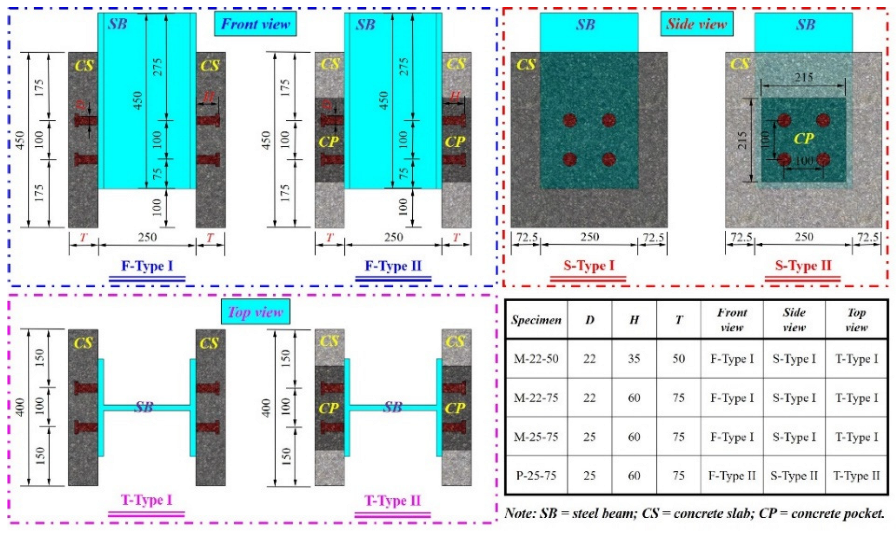
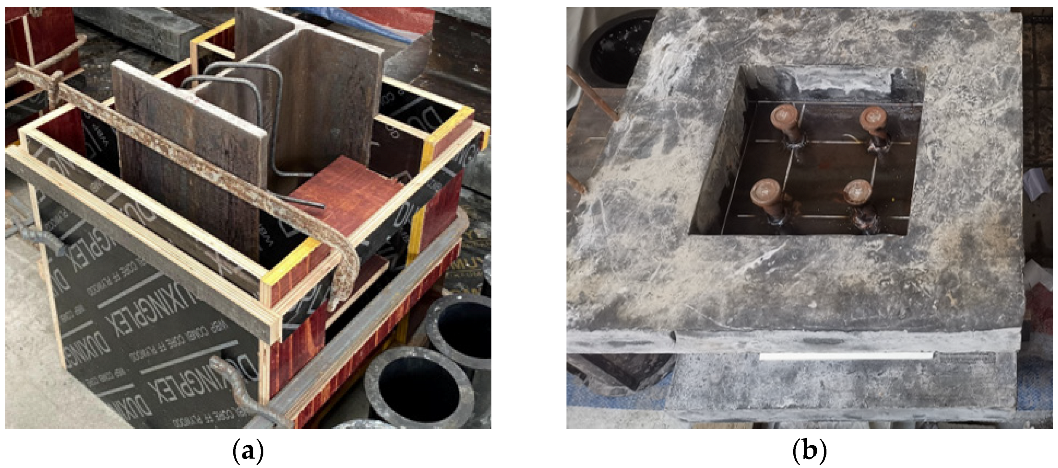
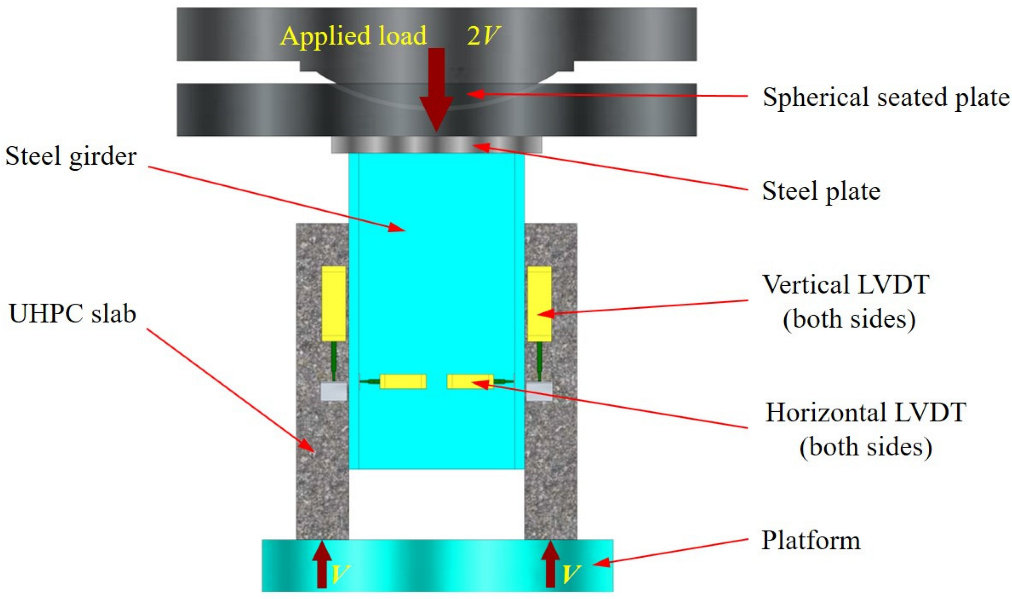
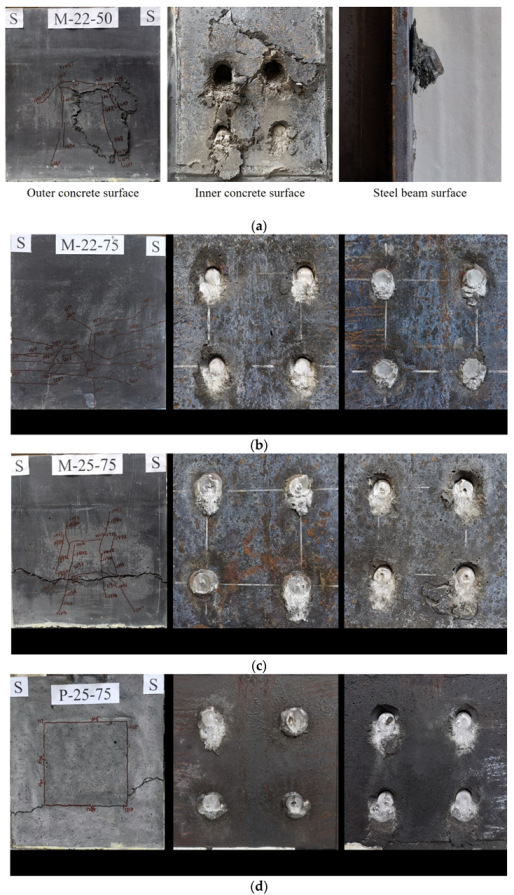
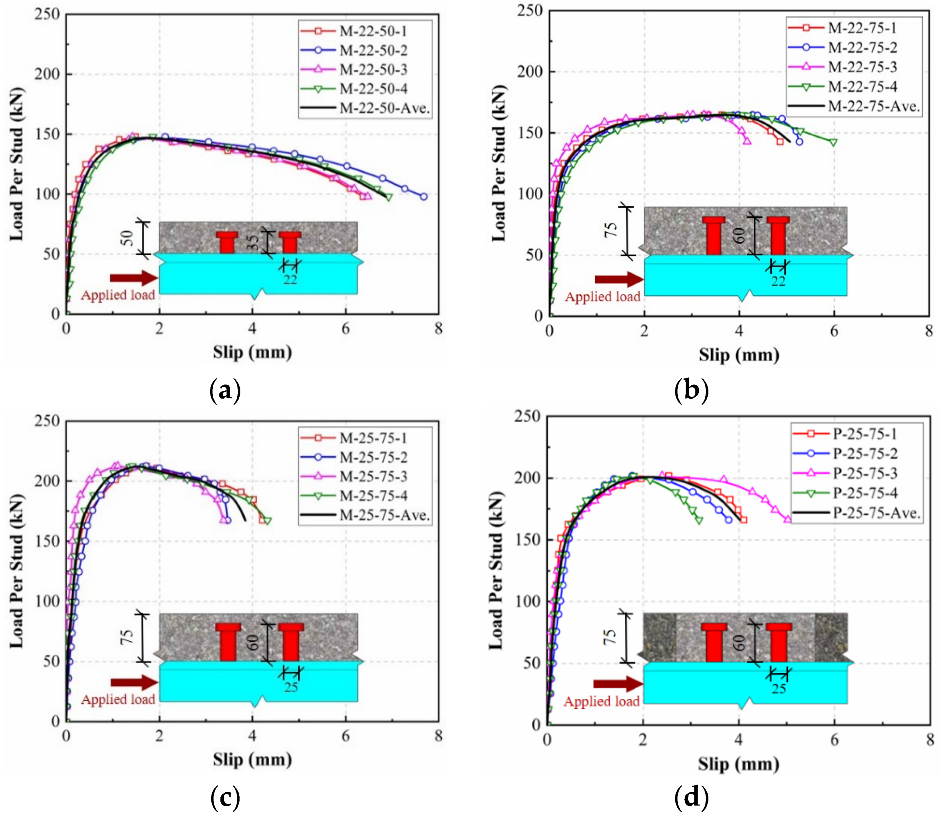
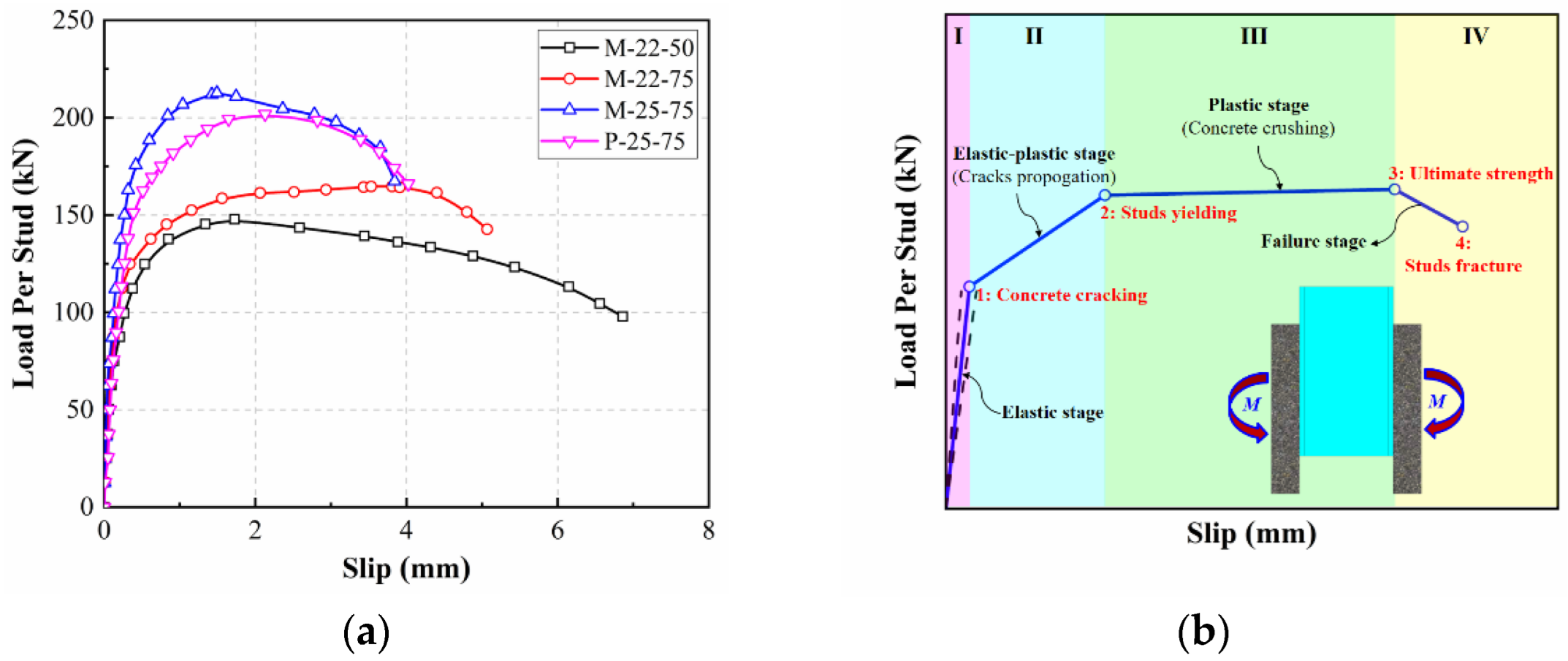
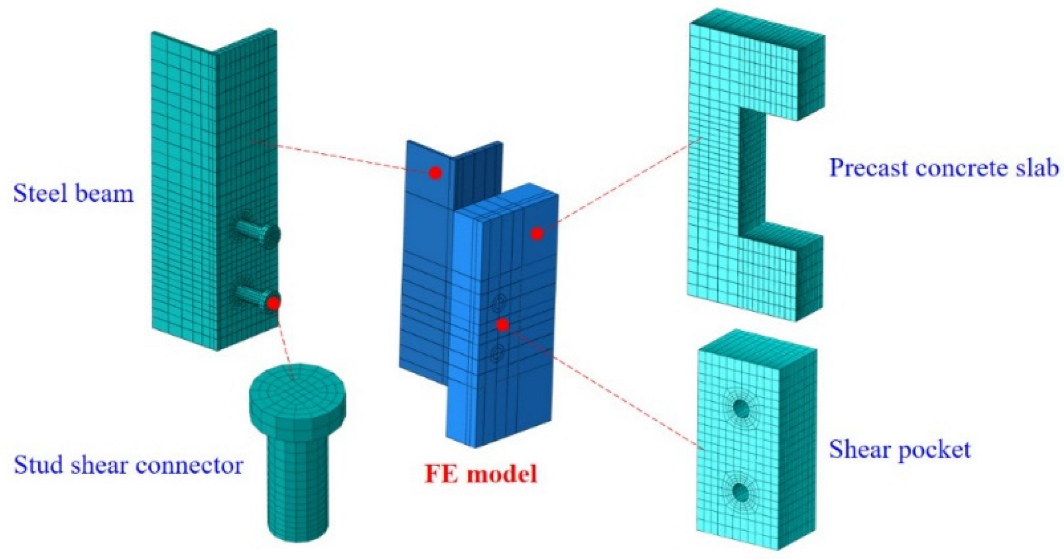
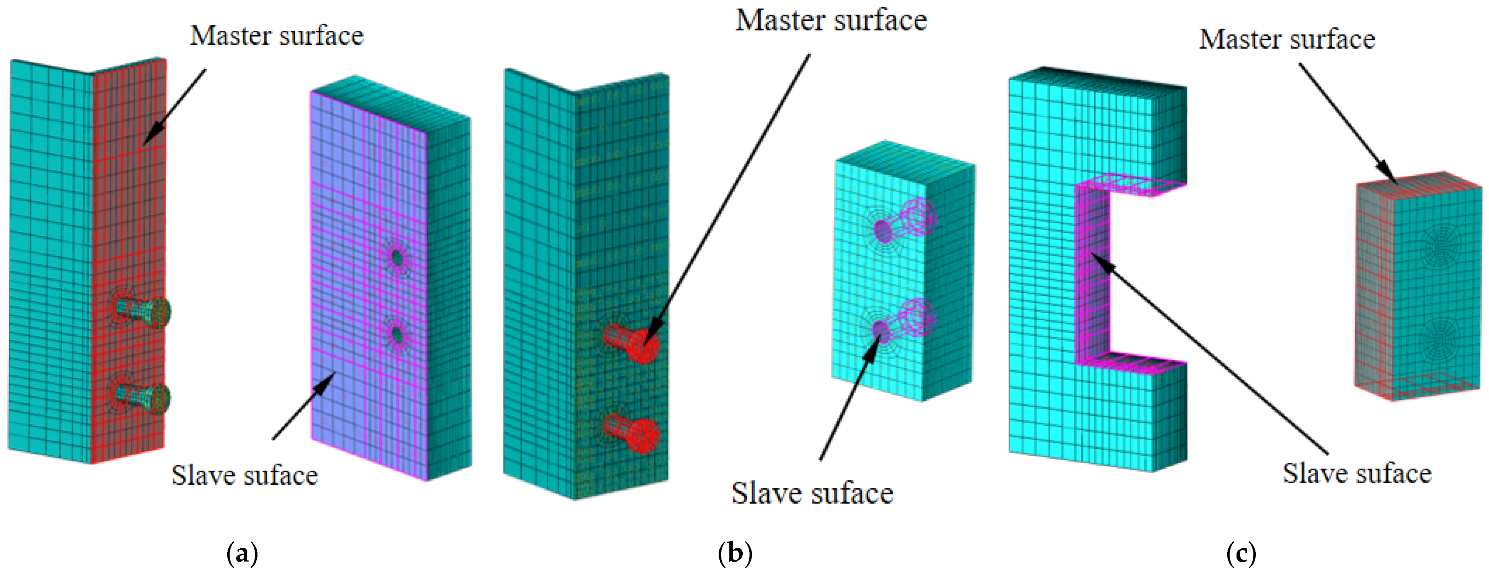


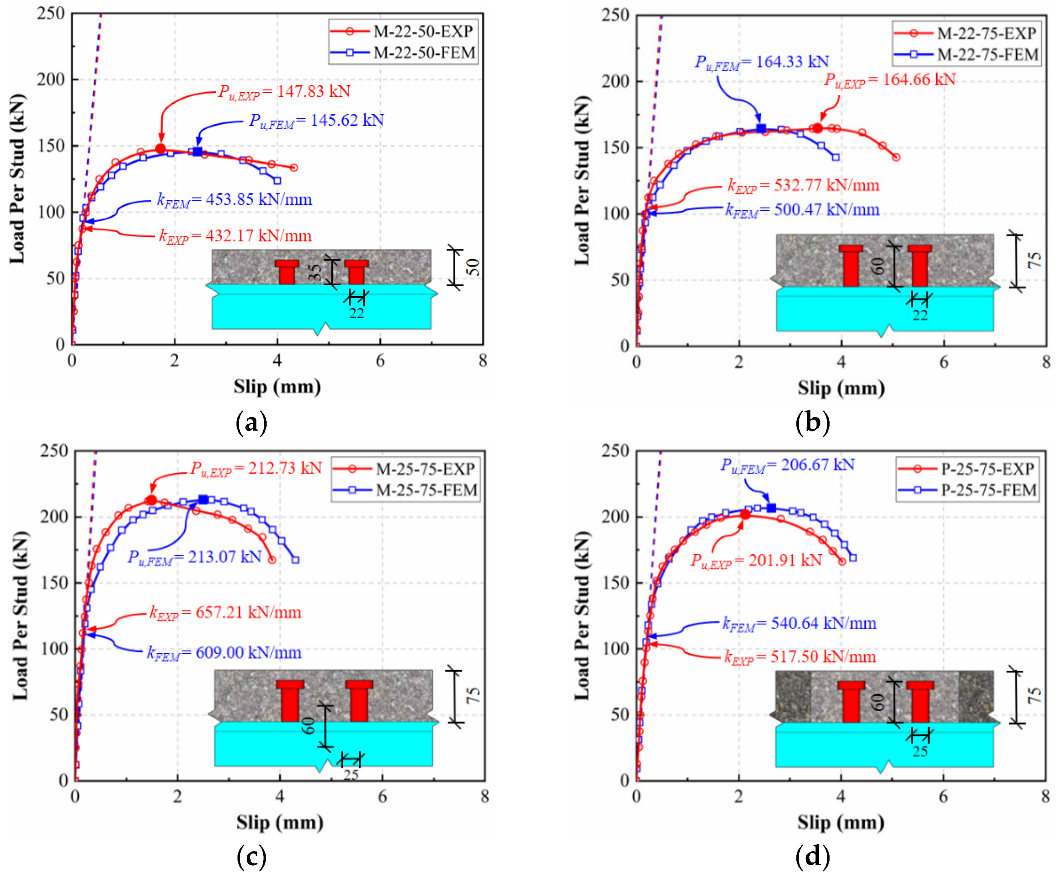
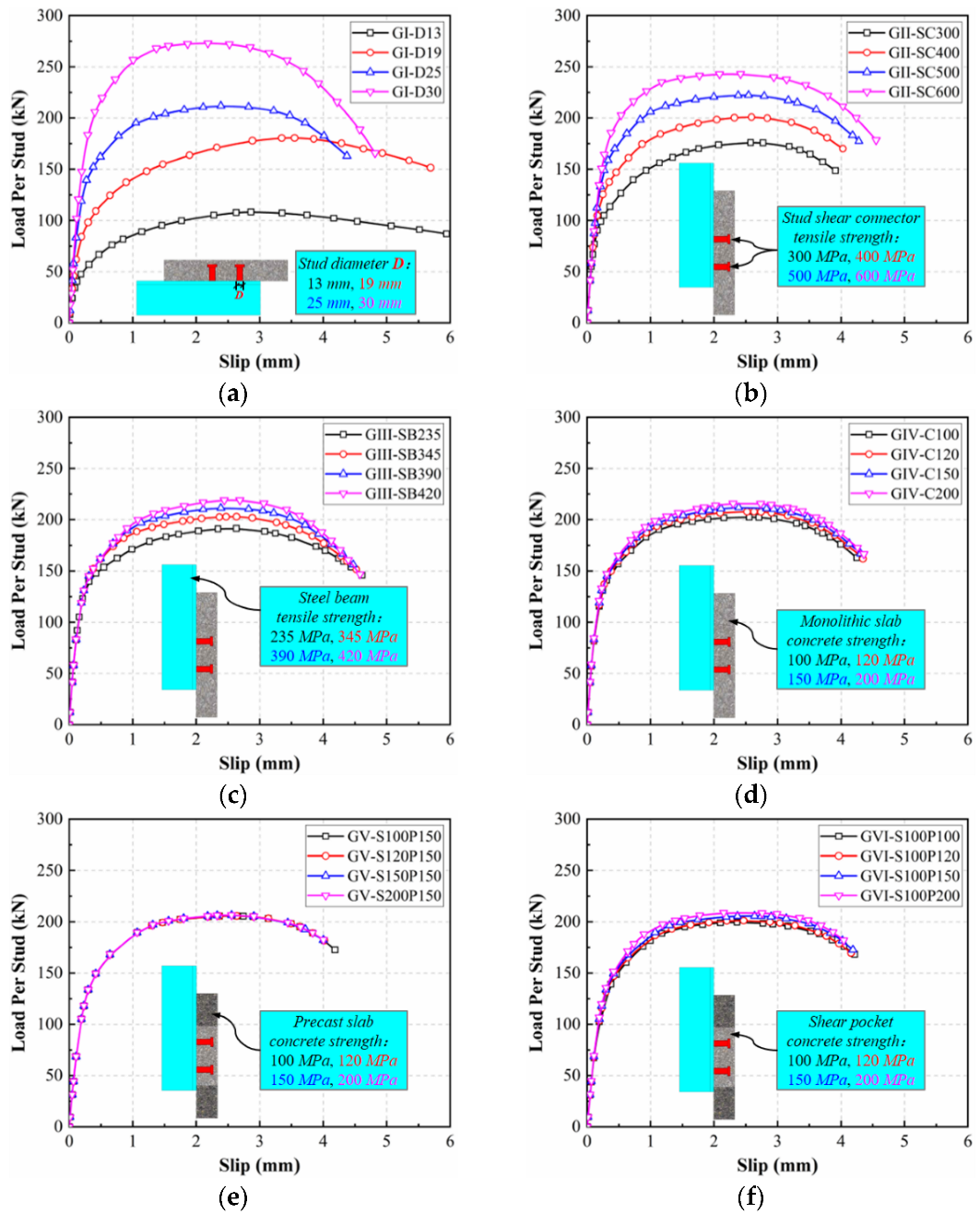
| Types | fc′ (MPa) | ft (MPa) | Ec (MPa) | v | |
|---|---|---|---|---|---|
| Concrete | Precast slab | 156.6 | 10.3 | 42890 | 0.205 |
| Shear pocket (former) | 159.1 | 10.8 | 43568 | 0.206 | |
| Shear pocket (latter) and monolithic slab | 150.5 | 10.2 | 42589 | 0.208 | |
| Types | ϕ22 stud | ϕ25 stud | Steel beam | ||
| Steel | Es (MPa) | 205300 | 208500 | 207130 | |
| fy (MPa) | 331.28 | 332.36 | 253.29 | ||
| fu (MPa) | 431.25 | 451.82 | 425.03 | ||
| Specimen | Aspect Ratio | Pu (kN) | k (kN/mm) | δu (mm) | δuk (mm) | Pcode-s (kN) | Pcode-s/Pu | Pcode-c (kN) | Pcode-c/Pu | Failure Mode |
|---|---|---|---|---|---|---|---|---|---|---|
| M-22-50 | 1.59 | 147.83 | 432.17 | 4.38 | 3.94 | 104.92 | 0.71 | 147.26 | 1.00 | Stud fracture/pulling-out and concrete spalling |
| M-22-75 | 2.73 | 164.66 | 532.77 | 4.90 | 4.41 | 104.92 | 0.64 | 212.07 | 1.29 | Stud fracture |
| M-25-75 | 2.40 | 212.73 | 657.21 | 3.36 | 3.02 | 141.94 | 0.67 | 249.63 | 1.17 | Stud fracture |
| P-25-75 | 2.40 | 201.91 | 517.50 | 3.66 | 3.29 | 141.94 | 0.70 | 249.63 | 1.24 | Stud fracture |
| Group | Specimen | Stud Diameter (mm) | Stud Tensile Strength (MPa) | Steel Beam Tensile Strength (MPa) | Concrete Strength | Casting Method | |
|---|---|---|---|---|---|---|---|
| Slab (MPa) | Shear Pocket (MPa) | ||||||
| I | GI-D13 | 13 | 452 | 425 | 150 | - | Monolithic |
| GI-D19 | 19 | ||||||
| GI-D25 | 25 | ||||||
| GI-D30 | 30 | ||||||
| II | GII-SC300 | 25 | 300 | 425 | 150 | - | Monolithic |
| GII-SC400 | 400 | ||||||
| GII-SC500 | 500 | ||||||
| GII-SC600 | 600 | ||||||
| III | GIII-SB235 | 25 | 452 | 235 | 150 | - | Monolithic |
| GIII-SB345 | 345 | ||||||
| GIII-SB390 | 390 | ||||||
| GIII-SB420 | 420 | ||||||
| IV | GIV-C100 | 25 | 452 | 425 | 100 | - | Monolithic |
| GIV-C120 | 120 | ||||||
| GIV-C150 | 150 | ||||||
| GIV-C200 | 200 | ||||||
| V | GV-S100P150 | 25 | 452 | 425 | 100 | 150 | Precast |
| GV-S120P150 | 120 | ||||||
| GV-S150P150 | 150 | ||||||
| GV-S200P150 | 200 | ||||||
| VI | GVI-S100P100 | 25 | 452 | 425 | 100 | 100 | Precast |
| GVI-S100P120 | 120 | ||||||
| GVI-S100P150 | 150 | ||||||
| GVI-S100P200 | 200 | ||||||
Publisher’s Note: MDPI stays neutral with regard to jurisdictional claims in published maps and institutional affiliations. |
© 2022 by the authors. Licensee MDPI, Basel, Switzerland. This article is an open access article distributed under the terms and conditions of the Creative Commons Attribution (CC BY) license (https://creativecommons.org/licenses/by/4.0/).
Share and Cite
Fang, Z.; Fang, S.; Liu, F. Experimental and Numerical Study on the Shear Performance of Short Stud Shear Connectors in Steel–UHPC Composite Beams. Buildings 2022, 12, 418. https://doi.org/10.3390/buildings12040418
Fang Z, Fang S, Liu F. Experimental and Numerical Study on the Shear Performance of Short Stud Shear Connectors in Steel–UHPC Composite Beams. Buildings. 2022; 12(4):418. https://doi.org/10.3390/buildings12040418
Chicago/Turabian StyleFang, Zhen, Shu Fang, and Feng Liu. 2022. "Experimental and Numerical Study on the Shear Performance of Short Stud Shear Connectors in Steel–UHPC Composite Beams" Buildings 12, no. 4: 418. https://doi.org/10.3390/buildings12040418
APA StyleFang, Z., Fang, S., & Liu, F. (2022). Experimental and Numerical Study on the Shear Performance of Short Stud Shear Connectors in Steel–UHPC Composite Beams. Buildings, 12(4), 418. https://doi.org/10.3390/buildings12040418








